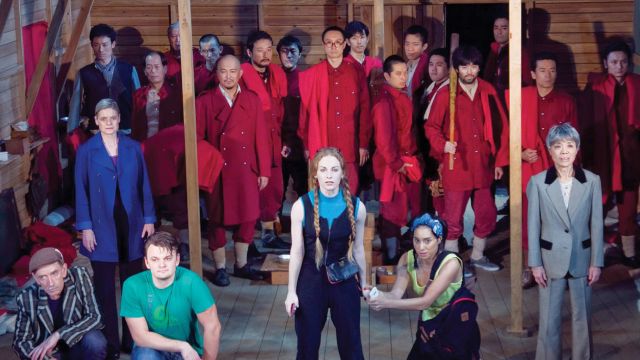Cowra No Hancho Kaigi (Honchos Meeting in Cowra)
The little NSW town of Cowra's major claim to fame is that it was the scene of the largest prisoner of war breakout ever in history. 1104 Japanese POWs set their huts on fire and stormed three rows of razor wire fences, protecting themselves with blankets, baseball mitts and clothing. 234 died, and the remainder were rounded up over several days. This production of Honchos Meeting in Cowra is to commemorate the 70thanniversary.
Yoji Sakate does not set out to retell the story as a straight documentary. Rather, the events take place within a film being produced by an all-female media student collective. By framing the story as a film within the play, Sakate is able (via his film students) to interact with the prisoner characters to explore what drove them to organise this mass escape in spite of their comparatively fair treatment. What ensues is a conversation between modern Australian culture and the past, and between Japanese culture pre- and post-World War II. As we see the production unit working to hone the movie, Sakate makes us aware of the creative process of trying to piece together what happened from the evidence.
In spite of the imaginative presentation, the play explains all the important facts as well as giving a realistic sense of what it must have been like to live in the overcrowded huts. The set reproduces half the cell interior to scale, complete with blankets, mats stuffed with newspaper, buckets that were used to surreptitiously brew sake, and other items the prisoners would have made. As the movie is honed, the sixteen POW characters move from almost ghosts to being fully fleshed out (based on Sakate’s interviews with surviving escapees). The acting is even and competent, and Sakate's hand as director is obvious throughout with the energetic pace and distinct and stylised characterisation right down to the most minor part. The dialogue is lively and full of wry humour and the audience, like the film makers and presumably Sakate himself, became involved with the prisoners' lives, making the prisoner's choice to die rather than remain imprisoned all the more tragic.
There’s music and militaristic dance punctuating the scenes, and plenty of movement and drama as the tragedy builds towards its inevitable end. Honchos Meeting in Cowra was an emotionally and intellectually satisfying experience which I highly recommend.
Cathy Bannister
Subscribe to our E-Newsletter, buy our latest print edition or find a Performing Arts book at Book Nook.

